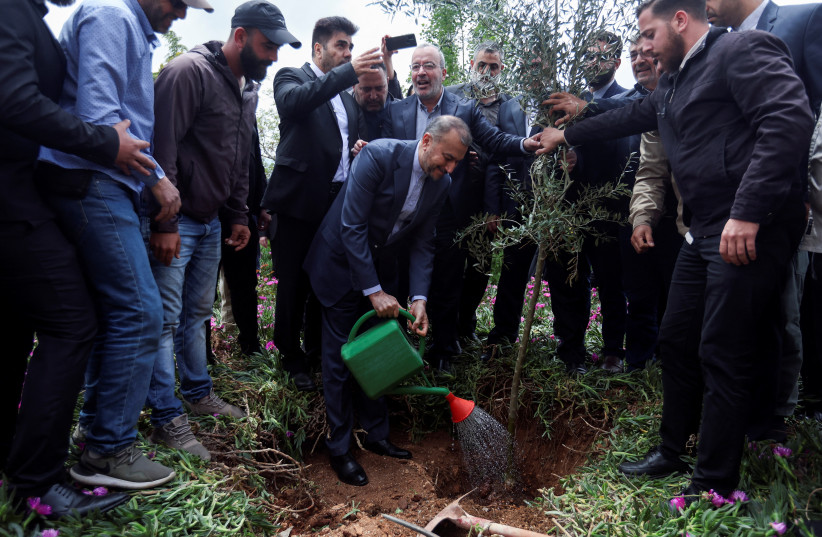Iran’s Foreign Minister Hossein Amir Abdollahian made a trip to southern Lebanon on Friday and made a provocative display of visiting an area overlooking Israel, close to the border of the two countries.
Iranian media highlighted his visit, which came at a time of crisis in Lebanon. Lebanon lacks a president because of Hezbollah’s influence and because the political parties are so divided they cannot agree on a candidate. In addition, Lebanon’s army has been involved in deporting Syrian refugees to Syria recently, potentially inflaming tensions between the countries.
According to reports, Iran’s foreign minister also visited the Maroun al-Ras village near the border with Israel, using the opportunity to speak with residents in the village.
The area of Maroun al-Ras was a key area for Hezbollah staging during the 2006 war with Israel, with a key battle being fought there. In addition, during the 2019 clashes, after Hezbollah fired anti-tank missiles across the border into Israel, Maroun al-Ras was shelled. Thus the village is seen as a key area for Iranian-backed Hezbollah “resistance.”
Abdollahian is on a visit to the region as part of Iran’s larger foreign policy goals, which include goals of strengthening its role in Syria and Lebanon. After signing a deal with Saudi Arabia, it is looking to wind down the war in Yemen. Then it will shift resources to Lebanon and Syria.

This visit could be a foreshadowing of that shift.
According to Iran’s state media outlet, Fars News, Abdollahian traveled to Beirut first and then went south to Maroun al-Ras before visiting the border with what Iran calls “occupied Palestine.” Here he planted several saplings near the border.
In a statement, the minister said he was “saluting the souls of the martyrs of the Palestinian and Lebanese resistance.” He mentioned Imad Mughniyeh, a key Hezbollah operative who was killed in Damascus in 2008, and IRGC Quds Force former leader Qasem Soleimani who was killed in a US drone strike in January 2020.
"Today we are in the border area of Maroun al-Ras and once again we are loudly supporting Lebanon's resistance against the Zionist occupation regime,” he said.
He also mentioned meeting Lebanese Hezbollah leader Hassan Nasrallah. Recently, Hezbollah facilitated a group of Hamas members to fire rockets at Israel over Passover, resulting in 34 rockets being fired. In addition, Iran encouraged a Palestinian group to fire rockets near the Golan.
Iran claims that the “resistance” groups it backs - such as Hezbollah - are in their best condition in years, despite suffering casualties in Syria that same week. In addition, Iran believes Israel is in decline and has been closely monitoring protests in Israel and seeking to destabilize the West Bank through weapons smuggling.
Iran's history with threatening Israel
This is not the first time that Iran has sought to send key parts of its axis to threaten Israel. In 2017, a pro-Iran militia leader from Iraq, Qais Khazali, traveled to Lebanon to also stand on the Israeli border and threaten Israel. This was when Iran was trying to threaten Israel using Iraqi militias such as Kataib Hezbollah in Iraq.
In addition to this, Abu Mahdi al-Muhandis established a base in Albukamal. In June 2018 an airstrike destroyed the Kataib Hezbollah headquarters in Albukamal, which is in Syria on the Iraqi border. In 2020, Abu Mahdi was killed alongside Soleimani in the US airstrike. However the Iranian-backed axis of Iraqi militias continued to infiltrate Syria and carve out a zone of influence along the Euphrates to Deir Ezzor and T-4 base and then to Damascus.
Near the Golan, Iran has encouraged Hezbollah to increase its role. This Hezbollah activity, known as the “Golan file” has increased its presence and threats as well.
The Alma Research and Education Center has researched the role of this Golan File and the Hezbollah force “whose purpose is to build terror cell infrastructures in southern Syria.”
In 2017 when Khazali visited the border, the organization MEMRI noted that “Qais Al-Khazali, the leader of the Iraqi Shi'ite militia Asa'ib Ahl Al-Haq, entered Lebanon and went on a tour of the Israeli-Lebanese border. In a video aired by the Iraqi Al-Ahd TV on December 8, Al-Khazali is seen listening to an explanation about the Israeli settlements across the border.”
At the time, the Iranian-backed militia leader was provided a view of Israel, including the village of Kfar Giladi. “There, next to the water reservoirs. The guys shot Grad Rockets and killed 12 Israelis over there. That’s the Golan. From the settlement of Dan and so on, you go straight up to the Golan. This road puts us within a distance of approximately 10 km [from Israel],” his guide says on the video.
“We are now at the Fatima Gate, in the town of Kafr Kila, on the border between southern Lebanon and occupied Palestine. Along with our brothers in Hizbullah, the Islamic Resistance, we declare our full readiness to stand alongside the Lebanese people, and the Palestinian cause against the oppressive Israeli occupation,” Khazali said.
This illustrates that the Iranian foreign minister’s visit is part of a larger process of symbolic threats that go back many years. These threats have manifested themselves with Iran’s attempt to move missiles and weapons to Hezbollah and Iran’s entrenchment in Syria.
